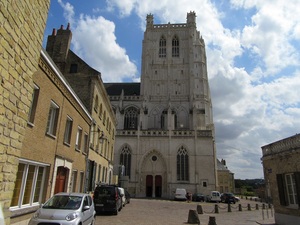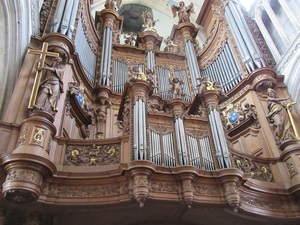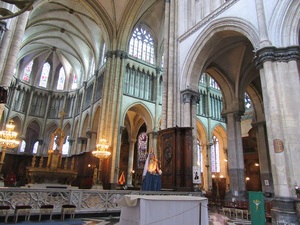Discover the grace and beauty of Saint-Omer Cathedral in northern France. It does not present the conventional architectural detail of sculpture encrusted entrance doors. It does contain a number of priceless art works so typical of the great cathedrals of France. They hang there rather invisibly in the darker, dustier corners where they are not formally displayed. St. Omer cathedral does though, demonstrate its own particular and unique individuality. It remains the centrepiece of this imposing medieval City.
 Many centuries ago, Saint Omer was a city whose population was roughly twice the size of what it is today. It was a medieval centre of great industrial, agricultural and civic importance. It was where Christianity was first brought to northern France by Saint Omer himself. He had the great cathedral founded during the 13th century. It remains today as an active place of Christian celebration and worship.
Many centuries ago, Saint Omer was a city whose population was roughly twice the size of what it is today. It was a medieval centre of great industrial, agricultural and civic importance. It was where Christianity was first brought to northern France by Saint Omer himself. He had the great cathedral founded during the 13th century. It remains today as an active place of Christian celebration and worship.
The founding Bishop of the Saint Omer diocese introduced long pilgrimages and hiking expeditions to raise money to help support children with walking difficulties in the region. He was the ‘founding father’ of sponsored walks in a way. Surely this is something that we all have a connection with in our own 21st century. Saint-Omer Cathedral is said to be the shrine of shoes. Saint-Omer Cathedral is also home to the most dominating and imposing ecclesiastical organ that is quite as impressive of any such similar instrument anywhere on the planet. This organ is not particularly well known or visited during our present times but surely it should be.
 Go inside Saint-Omer Cathedral and turn to face the western gallery. The face of the wall is dominated by the massive organ. It is a permanent component, almost, of the structure itself; it rules the form and culture of the great church. It generally remains silent and dormant as it surveys the interior from its lofty position.
Go inside Saint-Omer Cathedral and turn to face the western gallery. The face of the wall is dominated by the massive organ. It is a permanent component, almost, of the structure itself; it rules the form and culture of the great church. It generally remains silent and dormant as it surveys the interior from its lofty position.
The organ was originally created by Thomas and Jean-Jacques Desfontaines in 1717. It is huge and integrated with more than 115 pipes of various lengths. It originally included 45 playing stops. The wooden casework is an art form in its own right. The natural encasement is admired so much by organ ‘buffs’ from all countries. Saint-Omer’s organ could almost be the most majestic of such musical machines anywhere across the Christian world.
The organ, once constructed, was a very melodic instrument producing classically French tones. The stops and pedals were able to imitate many flute and wind instruments of varying sounds. The volume was powerful and filled the cathedral with an empowering sound. The vast bellows were originally person operated to provide the vast quantity of air needed to pressurise the pipes. It was a device of impressive persona.
 Restoration work on the organ was carried out by Aristide Cavaille-Coll during 1853 and 1855. He added to or partially changed 30 of the stops. He also altered the overall tone of the instrument to suit the modern idiom. The organ had initially a lower French tone but this was adjusted upwards.
Restoration work on the organ was carried out by Aristide Cavaille-Coll during 1853 and 1855. He added to or partially changed 30 of the stops. He also altered the overall tone of the instrument to suit the modern idiom. The organ had initially a lower French tone but this was adjusted upwards.
When the organ is played it requires a ‘crew’ of three people. The principal member plays the four keyboards. The one at the top has the higher keys and the bottom one, the lowest. The other two members operate the left and right stack of organ stops, assist with the array of foot pedals and turn the pages of the music as the sound progresses. I believe nowadays that only nine local people are authorised to play the instrument keyboards accompanied by their own assistants.
Nowadays, an electric pump is used to pressurise the bellows. The organ was classified as a Historical Monument in 1973.
The organ is vast, beautiful and domineering and the casing is a wonderful art work to appreciate in isolation. It is splendid to behold. During restoration a number of the pipes were re-fitted using their original metal material to preserve the celebrated French tones. Go and see it and listen to it if you can. The organ creates extraordinary, timeless and subtle music. Visit the audible video via the internet.











